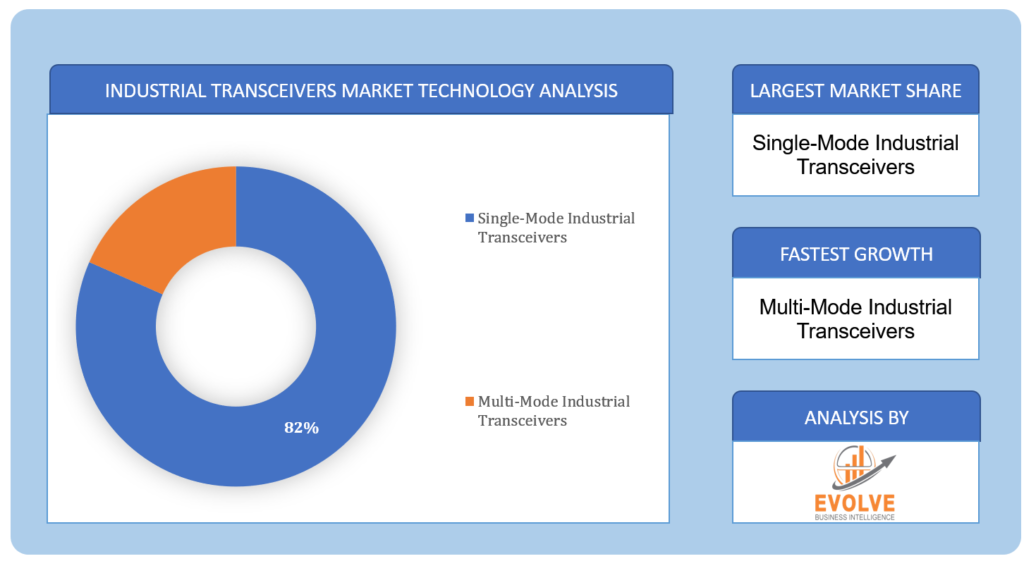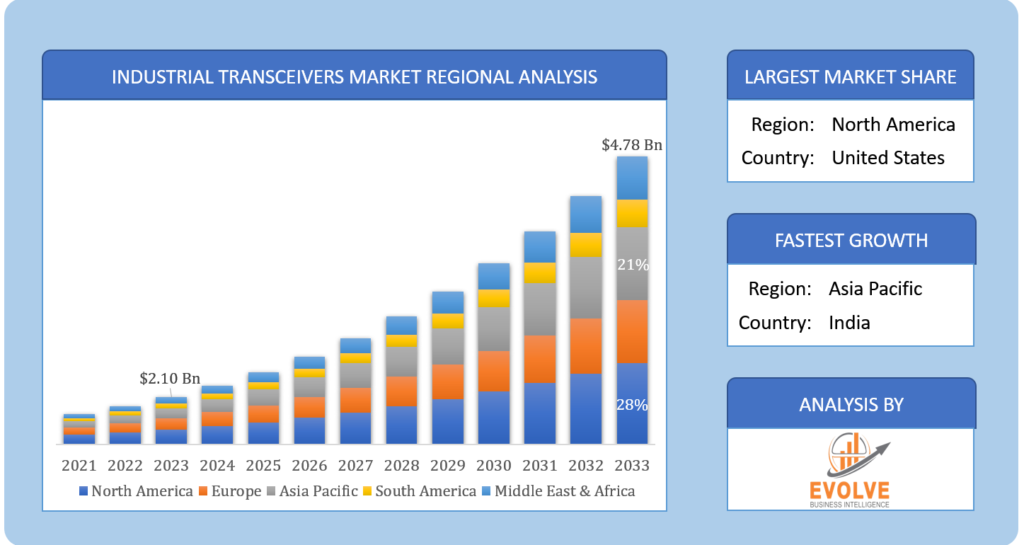Industrial Transceivers Market Overview
The Industrial Transceivers Market Size is expected to reach USD 4.78 Billion by 2033. The Industrial Transceivers industry size accounted for USD 2.10 Billion in 2023 and is expected to expand at a compound annual growth rate (CAGR) of 9.1% from 2023 to 2033. Industrial transceivers are specialized communication devices used in industrial settings to enable the exchange of data between various equipment and systems. These transceivers serve as the interface for transmitting and receiving data over different communication protocols, such as Ethernet, serial communication, or wireless connections, and are designed to withstand the harsh environmental conditions often encountered in industrial environments. They play a crucial role in connecting and coordinating machinery, sensors, controllers, and other industrial components, facilitating real-time data exchange and control processes essential for automation, monitoring, and management in industrial applications. Industrial transceivers are engineered for reliability, durability, and compatibility with industrial standards, making them essential components in modern industrial automation.
Global Industrial Transceivers Market Synopsis
The Industrial Transceivers market underwent a significant transformation driven by the repercussions of the COVID-19 pandemic. As industries sought to adapt to the challenges posed by the pandemic, there was a heightened demand for reliable and resilient communication solutions in industrial settings. This demand fueled the adoption of industrial transceivers, which play a pivotal role in ensuring seamless data connectivity and control within automated industrial systems. Industries increasingly recognized the importance of remote monitoring, automation, and data-driven decision-making to maintain operational continuity during lockdowns and supply chain disruptions. Consequently, the pandemic accelerated the integration of advanced communication technologies, including industrial transceivers, into industrial infrastructure, paving the way for a more connected and agile industrial landscape.
Industrial Transceivers Market Dynamics
The major factors that have impacted the growth of Industrial Transceivers are as follows:
Drivers:
Ø Industry 4.0 and Automation Trends
A significant driver for the Industrial Transceivers Market is the growing adoption of Industry 4.0 and automation technologies across various industries. As businesses strive for increased efficiency, productivity, and data-driven decision-making, the demand for robust and reliable communication solutions like industrial transceivers has surged. These devices facilitate the seamless exchange of data between industrial equipment, sensors, and control systems, enabling real-time monitoring and automation, which are crucial in modern manufacturing and industrial processes.
Restraint:
- High Initial Investment Costs
A notable restraint in the Industrial Transceivers Market is the high initial investment required for implementing these technologies. Industrial transceivers, especially those designed for rugged environments and specific industrial applications, can be costly. Additionally, integrating these devices into existing industrial infrastructure may necessitate further investment in terms of compatibility and infrastructure upgrades. These upfront costs can deter smaller companies or those with limited budgets from adopting industrial transceivers, particularly in industries with tight profit margins.
Opportunity:
⮚ IoT and Edge Computing Integration
An opportunity for the Industrial Transceivers Market lies in the integration of these devices with the Internet of Things (IoT) and edge computing technologies. Industrial transceivers can serve as essential components in building robust IoT ecosystems within industrial settings, enabling efficient data collection, processing, and decision-making at the edge of the network. This integration can lead to improved operational efficiency, predictive maintenance, and real-time insights, offering a significant growth avenue for the industry as IoT adoption continues to expand in various sectors.
Industrial Transceivers Segment Overview
By Technology
 Based on Technology, the market is segmented based on Single-Mode Industrial Transceivers and multi-mode Industrial Transceivers. The Single-Mode Industrial Transceivers segment is anticipated to experience significant growth throughout the forecast period in the Industrial Transceivers market due to its suitability for long-distance, high-speed data transmission, which is increasingly demanded in industrial applications like remote monitoring and smart factories.
Based on Technology, the market is segmented based on Single-Mode Industrial Transceivers and multi-mode Industrial Transceivers. The Single-Mode Industrial Transceivers segment is anticipated to experience significant growth throughout the forecast period in the Industrial Transceivers market due to its suitability for long-distance, high-speed data transmission, which is increasingly demanded in industrial applications like remote monitoring and smart factories.
By Application
Based on the Application, the market has been divided into Telecommunication and Data Processing, Automation, Power Management and Smart Grid, Electric Vehicles, Renewable Energy, and Lighting. The Telecommunication and Data Processing segment is expected to undergo substantial growth in the Industrial Transceivers market during the forecast period owing to the rising demand for high-speed data communication and connectivity solutions in the expanding telecommunications and data processing industries.
Global Industrial Transceivers Market Regional Analysis
Based on region, the global Industrial Transceivers market has been divided into North America, Europe, Asia-Pacific, the Middle East & Africa, and Latin America. North America is projected to dominate the use of the Industrial Transceivers market followed by the Asia-Pacific and Europe regions.
 North America Market
North America Market
North America has consistently upheld its dominant position in the Industrial Transceivers market, owing to a combination of factors. The region boasts a robust industrial sector that places a premium on automation, IoT integration, and data-driven operations. With industries such as manufacturing, energy, and logistics seeking to optimize their processes, the demand for reliable communication solutions, including industrial transceivers, has remained high. Furthermore, North America has been at the forefront of technological innovation, and its well-established telecommunications infrastructure has driven the adoption of advanced communication technologies in industrial settings. Government initiatives to promote Industry 4.0 and the Industrial Internet of Things (IIoT) have also played a pivotal role in sustaining North America’s leadership in the Industrial Transceivers market. As industries continue to embrace digital transformation, the region is well-positioned to maintain its dominant market position in the coming years.
Asia-Pacific Market
The Asia-Pacific region has emerged as a rapidly growing market for the Industrial Transceivers industry due to several key factors. This dynamic region is experiencing a surge in industrialization, manufacturing, and infrastructure development, creating a heightened demand for industrial communication solutions to support automation and connectivity. As industries in Asia-Pacific increasingly embrace Industry 4.0 principles and the Internet of Things (IoT), there is a growing need for robust and efficient communication networks, where industrial transceivers play a crucial role. Additionally, government initiatives aimed at promoting smart manufacturing and digital transformation across countries like China, India, and Japan are driving the adoption of advanced technologies, including industrial transceivers.
Competitive Landscape
The Global Industrial Transceivers market is highly competitive, with numerous players offering a wide range of software solutions. The competitive landscape is characterized by the presence of established companies, as well as emerging startups and niche players. To increase their market position and attract a wide consumer base, the businesses are employing various strategies, such as product launches, and strategic alliances.
Prominent Players:
- Eaton Corporation
- Renesas Electronics
- AMS technologies ag
- Infineon Technologies
- Fujitsu Ltd
- CTC Union Technologies Co Ltd
- Senra Tech
- Analog Devices Inc
- Cisco Systems Inc
- Finisar Corporation
Key Development
In June 2022, Fujitsu Optical Components Limited introduced a cutting-edge 100G QSFP28 BiDi Optical Transceiver, enabling high throughput capacity and cost savings for mobile and access networks.
In March 2022, STL, a prominent digital network integration firm, partnered with Analog Devices, Inc. to jointly develop 5G Open RAN radio units (O-RU). This collaboration aimed to create 5G-ready solutions that diversify the range of commercially accessible O-RUs, promoting the expansion of Open RAN networks.
Scope of the Report
Global Industrial Transceivers Market, by Technology
- Single-Mode Industrial Transceivers
- Multi-Mode Industrial Transceivers
Global Industrial Transceivers Market, by Application
- Telecommunication and Data Processing
- Automation
- Power Management and Smart Grid
- Electric Vehicles
- Renewable Energy
- Lighting
Global Industrial Transceivers Market, by Region
- North America
- US
- Canada
- Mexico
- Europe
- UK
- Germany
- France
- Italy
- Spain
- Benelux
- Nordic
- Rest of Europe
- Asia Pacific
- China
- Japan
- South Korea
- Indonesia
- Austalia
- Malaysia
- India
- Rest of Asia Pacific
- South America
- Brazil
- Argentina
- Rest of South America
- Middle East & Africa
- Saudi Arabia
- UAE
- Egypt
- South Africa
- Rest of Middle East & Africa
| Parameters | Indicators |
|---|---|
| Market Size | 2033: $4.78 Billion |
| CAGR | 9.1% CAGR (2023-2033) |
| Base year | 2022 |
| Forecast Period | 2023-2033 |
| Historical Data | 2021 |
| Report Coverage | Revenue Forecast, Competitive Landscape, Growth Factors, and Trends |
| Key Segmentations | Technology, Application |
| Geographies Covered | North America, Europe, Asia-Pacific, Latin America, Middle East, Africa |
| Key Vendors | Eaton Corporation, Renesas Electronics, AMS Technologies ag, Infineon Technologies, Fujitsu Ltd, CTC Union Technologies Co Ltd, Senra Tech, Analog Devices Inc, Cisco Systems Inc, Finisar Corporation |
| Key Market Opportunities | • Integration with IoT and Edge Computing |
| Key Market Drivers | • Increasing Adoption of Industry 4.0 and Automation Technologies |
REPORT CONTENT BRIEF:
- High-level analysis of the current and future Industrial Transceivers market trends and opportunities
- Detailed analysis of current market drivers, restraining factors, and opportunities in the future
- Industrial Transceivers market historical market size for the year 2021, and forecast from 2023 to 2033
- Industrial Transceivers market share analysis at each product level
- Competitor analysis with detailed insight into its product segment, Government and defense strength, and strategies adopted.
- Identifies key strategies adopted including product launches and developments, mergers and acquisitions, joint ventures, collaborations, and partnerships as well as funding taken and investment done, among others.
- To identify and understand the various factors involved in the global Industrial Transceivers market affected by the pandemic
- To provide a detailed insight into the major companies operating in the market. The profiling will include the Government and defense health of the company’s past 2-3 years with segmental and regional revenue breakup, product offering, recent developments, SWOT analysis, and key strategies.








